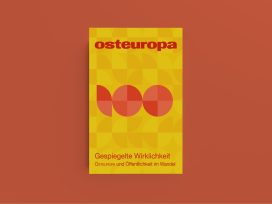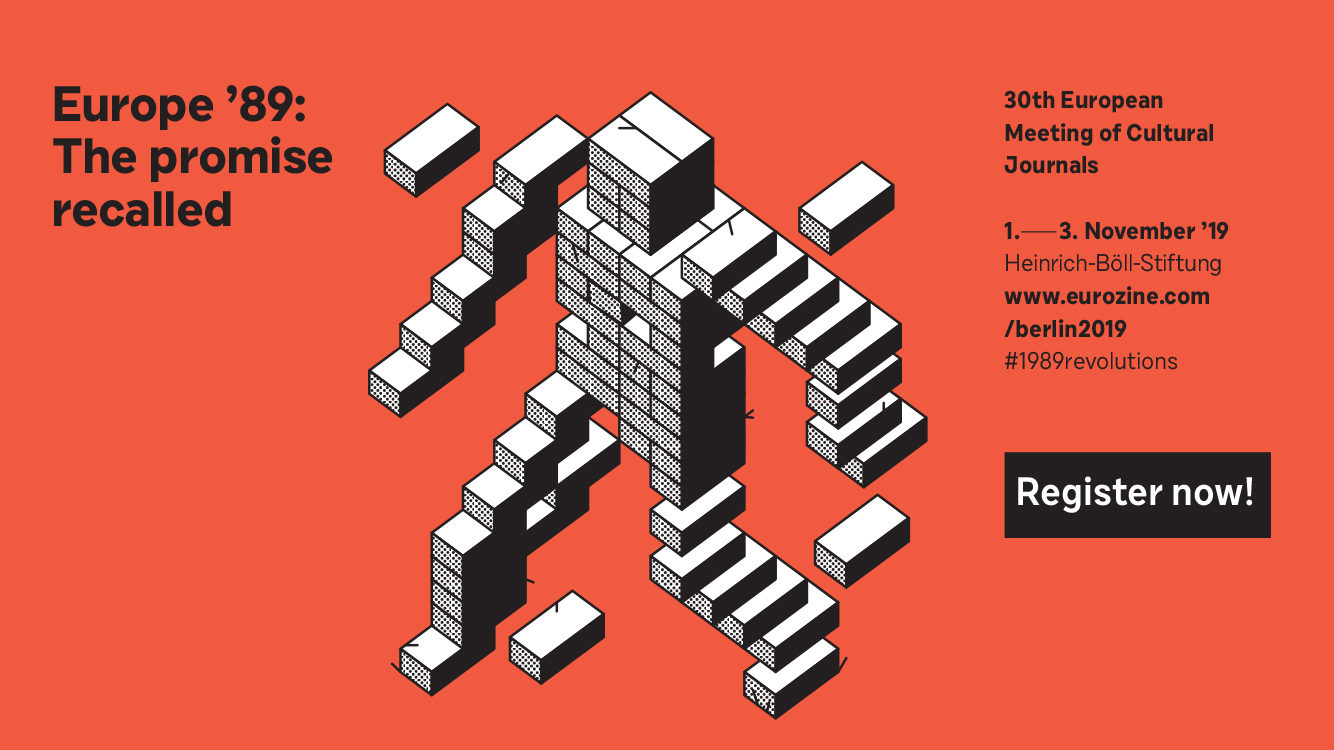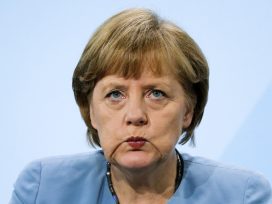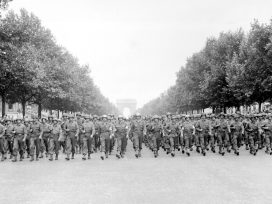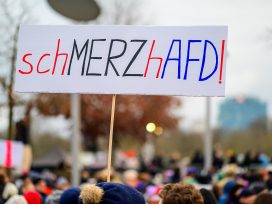The Berlin Wall, and the Iron Curtain bisecting Germany were the most striking and deadly aspects of the division of the European continent agreed by the Allies at Yalta. First and foremost, Germany’s families, friendship groups and social relations were rent apart. And although this dismemberment could be understood as a logical consequence of the crimes of the ‘Third Reich’, it wasn’t seen that way in Eastern Europe. From Riga to Sofia, one totalitarian foreign occupation had replaced another. Any hint of dissent was brutally crushed or cynically normalized by Soviet power and its satellites. There, the lack of state autonomy gave new life to the concept of national sovereignty, whereas in the west it was becoming easier to accept the passage of sovereignty over to a supranational European community.
And it was here that the ambiguous role of the German Democratic Republic acquired a particular significance. Although a part of the Warsaw Pact and the most industrially and technically advanced country in Comecon, the GDR was the object of suspicion amongst its peers both due to its particular loyalty to the Communist Party of the Soviet Union, and on anti-fascist, anti-German grounds. At the same time, the GDR had a love-hate relationship with the Federal Republic of Germany: both radically estranged from it as the ‘other Germany’, and longing to be reunited with it, whether under the banner of socialism or not. A (still largely implicit) GDR nationalism only arose in the 1970s: otherwise, East Germans were silent partners in ‘Deutschmark nationalism’ and the EU.
Ivan Krastev has advanced the theory that the Eastern Europeans who so enthusiastically joined the European Union for reasons of economics and security policy at some point began to regard it as a new ‘prison house of nations’, a kind of soft Soviet Union. While that was something of an exaggeration, it is a fact that people in countries of the former Eastern Bloc have become more estranged from the EU, and this sentiment exists in East Germany too, more strongly than in the west of the country. In the former GDR, too, the name ‘Brussels’ often inspires a postcolonial aversion, nostalgia for the Deutschmark, a yearning for greater representation, a nationalistic reserve.
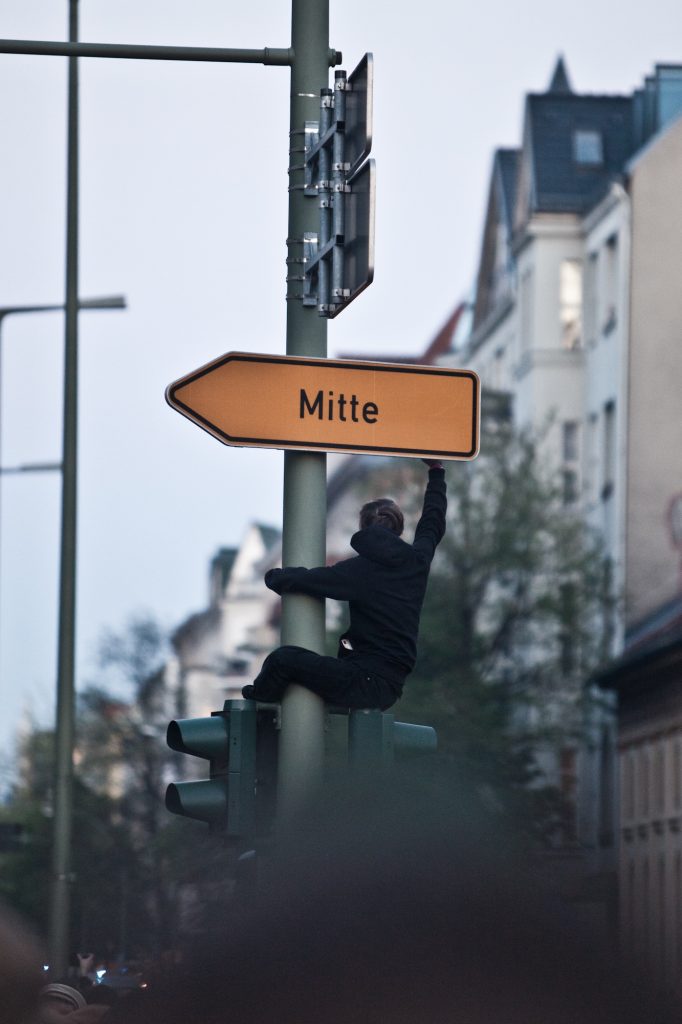
1 May demonstration (2011) in Kreuzberg, Berlin. Photo by Christian Lendl. Photo source: Flickr
In autumn 2019, state legislative elections will take place in parts of East Germany. While the European relevance of these elections ought to be clear enough, the established parties, including the post-communist Left, are fretfully watching Alternative für Deutschland draw level in the polls with the CDU, SPD and die Linke, now and then looking like the party set to leave its mark on the ‘new states.’ People are rubbing their eyes in disbelief: how could the völkisch-authoritarian right be the successor to the SED’s one-party state? For others it is no surprise, given the racist pogroms of 1991 in Hoyerswerda and 1992 in Rostock-Lichtenhagen during the early phase of ‘transformation’. Today, still the majority of acts of xenophobic hatred are committed in East Germany, which is also the home to the Pegida movement and an identitarian think-tank, the Institut für Staatspolitik. But that shouldn’t be seen as the East’s shame: Turkish families were murdered in West Germany, in Mölln in 1992 and in 1993 in Solingen; and the AfD originates from the western half of the country and cashes in considerable electoral success even there.
And when one sees the far right, anti-Islam sentiment and hatred against foreigners in the Ruhrgebiet, in the Swabian Alps and on the North Sea coast too, then the New Right in the east looks more like a warning about a failure of integration. Those living in the east in 1990s, or those visitors who kept their eyes and ears open, got a sense of the dissatisfaction that was welling up; one could tell that protests were on their way, and there was also a hint that a future people’s uprising wouldn’t be coming from the left. Since the early 1990s, every-day racism has become entrenched, and has become a part of the narrative that underpins the identity of a part of East German society. As a significant chunk of Party of Democratic Socialism [successor to the GDR’s ruling SED party] voters migrated over to AfD, xenophobia and racism became the vectors of an anti-democratic societal critique.
Failures of integration
In order to understand this rightward drift, we have to look back into the immediate post-reunification period. Driven on by the ‘Chancellor of Unity’ Helmut Kohl, 1990 saw the ‘rapid absorption’ option win out as the GDR joined the FRG. The somewhat threatening slogan of the day was: ‘if the Deutschmark doesn’t come to us, we’ll come to the Deutschmark.’ The alternative to the swift procedure provided for under the Federal Constitution’s Article 23 would have been the expensive and time-consuming convocation of a Constituent Assembly under Article 146. In such an assembly, the East German citizens’ movement would have been politically stronger and more numerous than under the party system imported from the West, which imposed the phenomenon of ‘party blocs’. At the time, most considered a Constituent Assembly utopian and risky: but today we are counting the cost of the failure to consider winding up the economically bankrupt and morally decrepit GDR in a way that went easier on its 16 million inhabitants. Kohl promised ‘blossoming landscapes’ meaning some renovated highways and stylish tourist hotspots, but what happened first was a veritable bloodbath of de-industrialisation, under the aegis of the ‘Treuhandgesellschaft’ which was so widely-detested by new Federal citizens. From a commercial point of view there was no choice but to wind these firms up; but the process provoked an exodus, and feelings of impotent rage amongst those who stayed behind.
As of this year, Germany has been united for a longer time than the Wall and its barbed wire stood. And this is to be the last year in which money from Solidarpakt II is spent in East German states. The end of an era? At first – and second – glance, the balance-sheet seems straightforwardly positive: living conditions – meaning infrastructure, wealth and the welfare state – have converged to a great extent. And what’s more, for many years now Germany has been ruled by former GDR citizen Angela Merkel, and in Joachim Gauck the country even had an Eastern Federal President. The SED regime was wound up swiftly; gaps and potholes found themselves filled. In many places, memorials have been erected to the repression carried out by the SED/Ministry of State Security and the history linking persecutors and victims whose paths now cross every day is passed over in ‘communicative silence’ (to paraphrase a bon mot coined by philosopher Hermann Lübbe in reference to the Nazi period). The generation born after 1980 live, work and study either side of the old wall and no longer notice much of a difference. Fundamentally they grew up after the wall: they have digested their parents’ and teachers’ adjustment problems, and now regularly travel across Europe’s disappearing borders.
And while the GDR was mentally bound up with the West before 1989, from 1990 onwards its westernisation raced on apace. The Bonn Republic’s institutional architecture was grafted wholesale onto the ‘new states’; only a few achievements of Actually Existing Socialism remained, whether in full or in part, like the amended abortion legislation. The initiatives of the East German citizens’ movement in democratic politics were largely ignored; the post-communist left struck anti-western postures and preached a socialist tradition which had never been practised in the GDR. The resulting weak party ties and distance from political, economic and intellectual elites paved the way to the expansion of the political system from three parties to six or more. Changes to the structure of society accompanied this easternisation: the Berlin Republic became more Protestant and at the same times more atheist; it took on more of a national and Eurosceptic character; and in the east of the country a national-neutral outlook persisted, as did a Russophilia unruffled by Vladimir Putin’s aggressive policies.
After 1990, thousands tumbled from the GDR’s ‘working society’ (Arbeitsgesellschaft), with its full employment and high proportion of women in work, into unfamiliar unemployment and early retirement, or else fell back into the role of a housewife or migrated west in great numbers. Since then, the labour market has evened itself out, first and foremost thanks to a higher level of women in employment. But at the same time, inequality has increased, with a widening gap between the income and wealth of the richest and that of the rest of society. Inequality was expressed in subjective assessments of one’s own share in the general wealth and comfort of society. For many of East Germany’s disproportionately numerous unemployed people, for ordinary workers and staff, and for specialists and bosses, it was found that ‘[i]n general, East Germans of almost all strata were much less likely than West Germans to consider their standard of living as fair.’
There hardened a feeling of not having made it in the new Germany, of not being respected there. ‘First off, integrate us!’ was the title of a 2018 polemic published by a politician who grew up in the GDR, and which spoke to the hearts of many ‘Ossis.’ The central contradiction of the post-reunification experience of East Germans, according to essayist Wolfgang Engler, was that ‘in the same moment that they achieve the thing they were striving towards, that is, political and civil rights, they suffer an untold loss of social security. That means that one part of the dream comes true, but on a very fragile basis, one where the ground easily shifts under their feet: and so the experience of democracy gives way to this other experience.’ That creates a powerful cognitive dissonance: ‘now we have made a revolution; now we have risen up; now we have done something that has rarely been done on German soil, namely an uprising, and a successful one at that, with real achievements. Yet at the same time, at the very same time, one’s life falls apart.’
A shortage of opportunities
This is the fatal counterpart to the parallel progress made in terms of both liberal democracy and the market in West Germany after 1949. Awareness of the issue crystallised in the Federal Government’s annual reports on the situation in the new states, in the creation of ‘Eastern Commissioners’ in governments and parties, and in the continuation of the Soli (the solidarity tax) and the Solidarpakt, through which the East was able to enjoy structural and regional assistance from the EU. The ideal of convergence is logical for a supra-national, extended welfare state, which works towards equal conditions within an internal market and progressive levelling-up of conditions of life.
The most recent report of 2018 underlined where this hadn’t worked, and how a levelling-up could be achieved. The biggest remaining differences fell under the heading of lower gross domestic product per capita; few cities like Jena and Leipzig were able to match the economic power of West German regions. ‘The compartmentalisation of the East German economy and a lack of headquarters of large companies are major reasons for these differences. Not a single East German firm is registered on the DAX-30 index of leading companies. Almost no large company has its headquarters in East Germany. Many East German businesses belong to West Germans or foreign firms. That doesn’t just reduce opportunities for development in the region. One impact of this structural difference is a lower rate of research and innovation activity, as well as less marked internationalisation. Lower productivity and a small number of top earners are also in evidence.’
The core problem still is the internal migration, above all, of young, well-qualified people from East to West Germany, which led to a dramatic fall in numbers of children in the early 1990s. Although the birth rate has risen again since, the population, and especially the working population, is still falling in East German Länder, and the average age is rising faster than in the West of the Republic. On this trajectory, the ratio between age groups in the east of Germany in the years to come will change to an even greater degree than in the west; the proportion of working-age people will drop markedly, while the proportion of those over 65 will rise considerably. For these reasons, East Germany is in the grip of a serious labour shortage that cannot be compensated by migrant labour because of latent or acute xenophobia.
In social terms, the adjustment was relatively successful. The recently-concluded convergence of pension levels was symbolically significant, because it implied recognition of lifetime contributions made under the GDR. East German wage rates are currently around 98% of what they are in the west, despite the fact that certain economists initially wanted to establish the eastern part of Germany as a temporary low-wage zone (which in many respects it did become). However: ‘The average level of actually-paid wages, determined by the structure of the economy as well as wage scales, and not determined by remuneration components read off from the scale, is 82% of the western level.’ The legal and social-political adjustments have largely come to an end, in particular concerning infrastructure, environmental quality, city and village landscapes, and healthcare. But while cities like Berlin, Potsdam, Leipzig, Dresden, Rostock, Magdeburg and Erfurt are growing and developing research and further education infrastructures, cultural and leisure facilities and tourist pulling-power, their hinterlands are often stagnating. And it is precisely in those hinterlands that the AfD is profiling itself as a home for the dissatisfied, and as the ‘party that cares.’ It is possible that East-West relations could even out as a knock-on effect of the increasing cost of living in West German metropoles: low rents, attractive landscapes, well-resourced childcare and a good education system would draw West Germans. However, this would call for more professional in health care, nurseries and schools in regions with weak infrastructure, and an expansion of broadband provision.
‘Completing unification’ is a topic in every Sunday speech. But structural inequalities are in some regards growing deeper, and, above all, East Germans’ subjective perceptions of their situation are growing worse, and their forecasts for the future are more pessimistic than those made by westerners. Germany has made extraordinary investments in infrastructure, and well created blossoming landscapes, but the people who live in them are offered little hope. But it would be fatal for this to instil a victim complex and establish ‘East German’ as a quasi-ethnic marker of identity in people’s hearts and minds.
It would be no less fatal to conflate the East German experience with the phenomenon of AfD/Pegida. The distinction between them can be seen in the fact that the slogan (stolen from the GDR citizens’ movement) Wir sind das Volk [We are the people] is only being wielded by a vocal minority, which cannot speak for the German people, and still remains a minority even in the Pegida stronghold of Dresden. The rallying of the Wutbürger (angry, reactionary citizens) draws its power first and foremost from the passivity or indolence of the majority, and secondly from secret sympathy for the xenophobic movement in bourgeois circles. It is also fuelled by major political missteps on the part of the Berlin government and the administrations of the five East German Länder, all of which are made up of various coalitions of mainstream centre-left (Thuringia, Brandenburg, Mecklenburg-West Pomerania) and centre-right (Saxony, Saxony-Anhalt) parties, whose voter bases are dwindling and whose leaders rule out grand coalitions. ‘Wagging the dog’ might be a fitting expression when the weaker part of a society moves the stronger part.
The East may have shown the West its own future
In those parts of Germany where the fewest migrants and refugees live, the mobilisation was catalysed by exaggerated reports of a ‘refugee crisis’ resulting from the acceptance of several hundred thousand refugees from Asia and Africa. The East German defensive reflex was similar to that seen in former Eastern Bloc states like Hungary, Poland and the Czech Republic, where humanitarian aid was opposed with arguments about how Muslims would not adapt to Christian culture – a cynical argument in light of the de-Christianisation of the whole region, for which Pegida is overcompensating with its politicised and affected ‘defence of the Christian West.’ But this refusal of European solidarity didn’t in any way reduce anyone’s willingness to accept structural and regional aid from the EU. In terms of GDP per capita, East Germany is miles ahead of most of the transition regions in Central and Eastern Europe, and indeed many southern regions of the EU. Because the EU’s economic power is surely set to fall after Brexit, statistically, the EU will become poorer on average, and Germany richer by comparison. That means that German regions will receive less from European structural assistance funds than before.
In summary: the distinct circumstances of the two German states haven’t quite been done away with in the post-reunification period. The six East German states (including Berlin) with around 16 million inhabitants did not seamlessly merge into a larger German society; the East-West difference remains marked and if anything greater than North-South difference. In the post-Soviet transformation process, the GDR was privileged above other former Eastern Bloc states in that it was placed under the social-economic guardianship of the West German elites, and underwent an intensive economic transfer, which alas resulted in substantial problems for East Germans’ collective self-image and identity.
The opportunity to establish a new Germany in the fire of the East German Bürgerrevolution will not come again. The status quo is a widespread feeling of alienation, which has become all the more entrenched in recent years in spite of advances in material wellbeing and social cohesion; and this feeling will be difficult to address through social-political redistribution. While infrastructure in the East German states has improved greatly, a subjective feeling of second-class citizenship is rife, as some areas really have been left behind in terms of healthcare, entertainment facilities, digital connectivity and offline shopping opportunities. This is the result of a major fall in population and increase in the average age, which could create a vicious circle. This cycle cannot be broken through large-scale investment on a scattergun basis, but rather through surgical interventions targeted at particular deprived spots alone. Such initiatives cannot be left to administrations or parties alone: they require active and engaged citizens. And therein may lie the seeds of a second vicious circle: the ‘debourgeoisement’ of the GDR and the maintenance of welfare-state-centred passivity dampen the life of civil society. But civil society flourishes in many places; fostering it further and initiating democratic experimentalism is the most important political task of all, and not only in East Germany.
